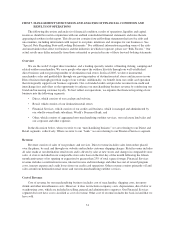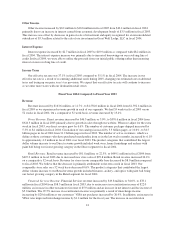Cabela's 2005 Annual Report Download - page 46
Download and view the complete annual report
Please find page 46 of the 2005 Cabela's annual report below. You can navigate through the pages in the report by either clicking on the pages listed below, or by using the keyword search tool below to find specific information within the annual report.default rates, delinquencies and charge-offs by continuing our underwriting and account management standards
and practices. We anticipate that we will continue to sell our credit card loans in the securitization markets and
manage those customer accounts at the bank.
Increase in interchange income. We have experienced an increase in interchange fee income as VISA raised
the interchange rate charged to merchants in 2004, and we participated in a new reward program with VISA in
2005 that increased our interchange income. These changes accounted for a $5.7 million and $1.4 million
increase in revenue, or 5.24% and 1.8% of our total Financial Services revenue, in fiscal 2005 and fiscal 2004,
respectively.
Influences on Period Comparability
We believe that the following factors have the potential to materially impact the comparability of our results
of operations if they differ from period to period:
•New destination retail store openings. The timing and number of our new destination retail store
openings will have an impact on our results. First, we incur one-time expenses related to opening each
new destination retail store. New store expenses for our large-format destination retail stores, the
majority of which are incurred prior to the store’s opening, averaged approximately $2.2 million per
store in 2005 and are expensed as incurred. Historically, we have received support from our vendors in a
variety of forms, including merchandise, purchase volume discounts and cooperative advertising
allowances. This support has helped to offset the cost of opening our new destination retail stores and is
typically recorded either as a direct reduction of the related selling, general and administrative expenses
being reimbursed, or as a general reduction to inventory costs. As we have begun to open more than one
destination retail store in a year, the support that we have received has decreased on a per store basis.
Second, most destination retail store expenses vary proportionately with revenue, but there is also a
fixed cost component, consisting primarily of occupancy costs, utilities and management overhead.
These fixed costs typically result in lower store profitability when a new destination retail store opens.
Due to both of these factors, a new destination retail store opening may result in temporary declines in
operating income, both in dollars and/or as a percentage of revenue. As the number of destination retail
stores increases, the fixed costs will be spread over a broader Retail revenue base and should not
represent the same disproportionate percentage of revenue in the future.
•Securitization of credit card loans. During the first quarter of 2003, we completed two securitization
transactions, which resulted in a reduction in securitization income of $1.3 million. We completed a
securitization transaction in the second quarter of 2004 in which we sold $75.0 million of fixed rate
notes and $175.0 million of floating rate notes, which contributed to a reduction in securitization income
of $3.1 million. These reductions in securitization income do not have a material impact on the full
fiscal year 2004 results when compared to the prior full fiscal year results. In fiscal 2005, we completed
a securitization transaction in the fourth fiscal quarter. However, due to the structure of the
securitization there was no reduction of securitization income. The timing and structure of these
securitization transactions can cause fluctuations in our quarterly results.
•Rapid interest rate changes. During periods of falling interest rates, our Financial Services segment
generally benefits as the variable rate of interest paid in connection with our securitization programs and
borrowings generally falls more rapidly than the interest rates charged to our cardholders. During
periods of rising interest rates, we generally experience the opposite effect. Interest rates declined or
were steady in the periods presented prior to 2005 in our selected financial data. The recent increases in
interest rates have not materially impacted the operating results of our Financial Services segment as we
have obtained favorable fixed interest rates for a portion of our securitizations and borrowings and have
been able to increase the interest rates paid by our cardholders.We cannot assure you that we will be
able to obtain similar fixed interest rates for our securitizations and borrowings in the future. See “Risk
Factors—Risks Related to Our Financial Services Business—Changes in interest rates could have a
negative impact on our earnings.”
34
























